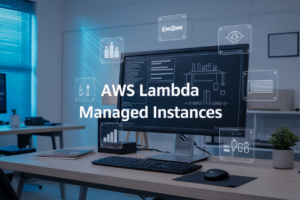Ever stared at your screen for hours trying to deploy HumanGov across multiple state servers, wondering if there’s a better way than manual configuration and SSH nightmares? You’re not alone. Government IT teams across the country are drowning in deployment complexity while security auditors breathe down their necks.
Here’s what you need to know: securely deploying HumanGov on AWS EC2 doesn’t have to be a bureaucratic mess.
I’ve spent years helping state agencies automate their infrastructure, and the combination of Ansible and GitOps with CodeCommit has revolutionized how we handle multi-state deployments. The approach slashes deployment time while actually improving security compliance.
But here’s the kicker – most teams get the initial setup wrong, which creates headaches that compound with every new server. Let me show you the exact framework that changed everything.
Understanding HumanGov Platform Architecture
Core components and services of HumanGov
HumanGov’s architecture consists of five key components: a user portal, case management system, database layer, integration APIs, and security modules. These work together to create a robust platform that handles citizen data while maintaining strict compliance with FISMA, NIST, and state-specific regulations.
Multi-state deployment requirements
Deploying HumanGov across states isn’t just copying and pasting code. Each state has unique requirements, from California’s strict privacy laws to New York’s specific data retention policies. The platform needs configurable modules and data segregation to meet these diverse needs without creating separate codebases.
Security considerations for government applications
Government apps like HumanGov face unique security challenges. They’re prime targets for attacks, handle sensitive citizen data, and must meet stringent compliance requirements. Your deployment needs multi-factor authentication, end-to-end encryption, regular security audits, and proper IAM controls to keep citizen data safe.
AWS EC2 compatibility with HumanGov
AWS EC2 and HumanGov go together like peanut butter and jelly. EC2’s scalability handles fluctuating citizen traffic, its instance types match different workloads, and its integration with security services like AWS Shield and WAF provides protection. Plus, EC2’s availability zones ensure continuity of government services.
Setting Up AWS Infrastructure
A. Configuring VPC with security groups
Your VPC is the foundation of your HumanGov deployment. Set up isolated subnets across availability zones, with strict security groups that only allow necessary traffic. Remember: an overly permissive security group is like leaving your front door wide open in a sketchy neighborhood. Nobody wants that.
Implementing GitOps Workflow with CodeCommit
Creating and configuring CodeCommit repositories
Ever tried herding cats? Setting up CodeCommit repos for HumanGov feels similar. Create separate repositories for infrastructure code, application code, and configuration files. Name them consistently like humangov-infra, humangov-app, and humangov-config to keep your team sane.
Establishing branch protection rules
Don’t let cowboys push straight to main! Configure branch protection rules requiring minimum two reviewer approvals before merging. Block force pushes and prevent branch deletion to maintain code integrity and audit trail compliance.
Setting up CI/CD pipelines
CodeBuild and CodePipeline are your new best friends. Connect them to your repos for automatic testing, building, and deployment. Configure separate pipelines for dev, staging, and production environments with appropriate approval gates between stages.
Implementing pull request reviews and approval process
PR reviews aren’t just bureaucracy—they’re your safety net. Set up mandatory review templates requiring security checklist verification, compliance attestation, and testing evidence. Configure email notifications so nothing slips through the cracks.
Ansible Configuration for Automated Deployments
A. Creating reusable Ansible roles for HumanGov
Think Lego blocks, but for your deployment. That’s what Ansible roles are. Break down your HumanGov deployment into standalone components like database, web server, and security. Each role handles one job perfectly. Need to update just the database config? Touch only that role. This modular approach saves you headaches when scaling across multiple states.
Security Hardening for Production Environments
Implementing AWS Security Hub Controls
Look, securing HumanGov isn’t optional. AWS Security Hub gives you a single dashboard for all security controls across your deployments. Enable automated compliance checks against CIS benchmarks and NIST frameworks. You’ll spot misconfigurations before they become breaches. Trust me, your security team will thank you later.
Configuring GuardDuty for Threat Detection
Multi-State Deployment Strategy
A. Managing environment-specific configurations
Ever tried deploying the same app across California, Texas, and New York simultaneously? It’s a nightmare unless you’ve got solid environment configs. We store state-specific variables in separate files, use Ansible vault for secrets, and implement hierarchical variable precedence. This way, California gets California-specific settings while core functionality stays consistent everywhere.
B. Implementing blue-green deployment methodology
Blue-green deployments aren’t just fancy tech jargon—they’re lifesavers when rolling out HumanGov across states. We maintain two identical environments (blue and active, green and staged) for each state. New code hits the inactive environment first, gets tested thoroughly, then we switch traffic over with a simple DNS update. Zero downtime means citizens don’t even notice the change.
C. Designing rollback procedures
Rollbacks shouldn’t be Plan B—they should be Plan A. Our system maintains snapshots of successful deployments and stores state configurations in version-controlled repositories. If something breaks in New Mexico, we can flip back to the previous working version in minutes, not hours. The rollback process is fully automated—no late-night scrambling required.
D. Creating state-specific data isolation mechanisms
State data isolation isn’t optional—it’s mandatory. Each state’s deployment uses dedicated database schemas with strict access controls. We implement VPC isolation on AWS to create network boundaries between state environments. Data never crosses state lines unless explicitly permitted through our API gateway with comprehensive audit logging.
E. Establishing monitoring for cross-state deployments
You can’t fix what you can’t see. Our monitoring combines centralized and distributed approaches. CloudWatch dashboards track system-wide metrics while state-specific Grafana instances monitor local performance. We’ve built custom alerting thresholds for each state based on typical usage patterns. When Idaho’s traffic spikes at tax time, our system knows that’s normal—not an incident.
Compliance and Governance
A. Meeting state-specific regulatory requirements
Deploying HumanGov across states isn’t just a technical challenge—it’s a compliance maze. Each state has its own data sovereignty rules, privacy laws, and security frameworks. Your deployment strategy needs state-specific configuration files in AWS that automatically apply the right compliance settings depending on where your instance spins up.
Deploying HumanGov across multiple states requires a thoughtful approach to security, automation, and compliance. By leveraging AWS EC2’s robust infrastructure, implementing GitOps workflows with CodeCommit, and utilizing Ansible for consistent configuration management, government agencies can ensure reliable and secure deployments. The security hardening measures and compliance frameworks discussed provide essential guardrails for protecting sensitive citizen data.
The multi-state deployment strategy outlined here offers a blueprint that balances standardization with the flexibility needed to accommodate state-specific requirements. As you move forward with your HumanGov implementation, remember that success lies in treating infrastructure as code, embracing automation, and maintaining rigorous security practices. Your efforts will ultimately create more responsive, efficient government services that better serve citizens while maintaining the highest standards of data protection and operational excellence.



















